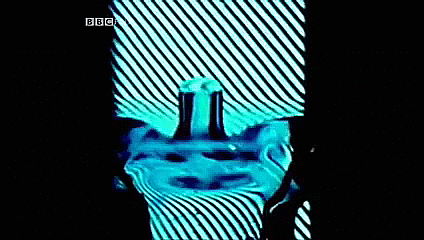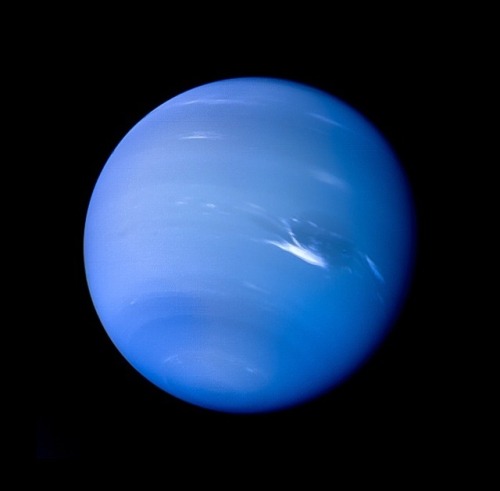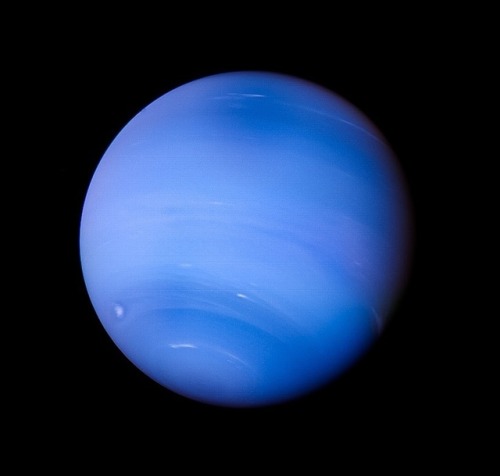Venus, Jupiter And Mars At Dawn - Oct 22, 2015

Venus, Jupiter and Mars at Dawn - Oct 22, 2015
Image credit: Joseph Brimacombe
More Posts from Riekod and Others


Superfluidity consists of an anomalous liquid state of quantum nature which is under a very low temperature behaving as if it had no viscosity and exhibiting an abnormally high heat transfer. This phenomenon was observed for the first time in liquid helium and has applications not only in theories about liquid helium but also in astrophysics and theories of quantum gravitation.
Helium only ends boiling at 2.2 K and is when it becomes helium-II (superfluid helium), getting a thermal conductivity increased by a million times, in addition to becoming a superconductor. Its viscosity tends to zero, hence, if the liquid were placed in a cubic container it would spread all over the surface. Thus, the liquid can flow upwards, up the walls of the container. If the viscosity is zero, the flexibility of the material is non-existent and the propagation of waves on the material occurs under infinite velocity.

Because it is a noble gas, helium exhibits little intermolecular interaction. The interactions that it presents are the interactions of Van der Waals. As the relative intensity of these forces is small, and the mass of the two isotopes of helium is small, the quantum effects, usually disguised under the thermal agitation, begin to appear, leaving the liquid in a state in which the particles behave jointly, under effect of a single wave function. In the two liquids in which cases of superfluidity are known, that is, in isotopes 3 and 4 of helium, the first is composed of fermions whereas the second is composed of bosons. In both cases, the explanation requires the existence of bosons. In the case of helium-3, the fermions group in pairs, similar to what happens in the superconductivity with the Cooper pairs, to form bosons.

Helium’s liquidity at low temperatures allows it to carry out a transformation called Bose–Einstein condensation, in which individual particles overlap until they behave like one big particle.
Superfluid in astrophysics
The idea of superfluids existed within neutron stars was proposed by Russian physicist Arkady Migdal in 1959. Making an analogy with Cooper pairs that form within superconductors, it is expected that protons and neutrons in the nucleus of a star of neutrons with sufficient high pressure and low temperature behave in a similar way forming pairs of Cooper and generate the phenomena of superfluidity and superconductivity.

The existence of this phenomenon was proven by NASA in 2011 when analyzing the neutron star left by supernova Cassiopeia A.
sources: 1, 2, 3 & 4 animation: 1 & 2
The Unreasonable Effectiveness of Mathematics in the Natural Sciences
Scholars have often expressed astonishment for how well mathematics works to describe our physical world. In 1960, Eugene Wigner published an article with the title above commenting that
…the mathematical formulation of the physicist’s often crude experience leads, in an uncanny number of cases, to an amazingly accurate description of a large class of phenomena.
Here are some others’ thoughts:
The most incomprehensible thing about the universe is that it is comprehensible.
— Albert Einstein
Physics is mathematical not because we know so much about the physical world, but because we know so little; it is only its mathematical properties that we can discover.
— Bertrand Russell
How can it be that mathematics, being after all a product of human thought which is independent of experience, is so admirably appropriate to the objects of reality?
— Albert Einstein
Our physical world doesn’t have just some mathematical properties, it has only mathematical properties.
— Max Tegmark
Physicists may have fallen prey to a false dichotomy between mathematics and physics. It’s common for theoretical physicists to speak of mathematics providing a quantitative language for describing physical reality… But maybe… math is more than just a description of reality. Maybe math is reality.
— Brian Greene
More info at https://en.wikipedia.org/wiki/The_Unreasonable_Effectiveness_of_Mathematics_in_the_Natural_Sciences

the fact that stars even exist and we can look at them every night for free just makes me go !!!!!!!!!!!!!!

The First Real Photo Of Entire Earth From Apollo 8 In 1968.


images of Neptune taken by Voyager 2 on August 24 1989.
Credit: NASA/JPL-Caltech/Kevin M. Gill
Stellar Winds
Stellar winds are fast moving flows of material (protons, electrons and atoms of heavier metals) that are ejected from stars. These winds are characterised by a continuous outflow of material moving at speeds anywhere between 20 and 2,000 km/s.

In the case of the Sun, the wind ‘blows’ at a speed of 200 to 300 km/s from quiet regions, and 700 km/s from coronal holes and active regions.

The causes, ejection rates and speeds of stellar winds vary with the mass of the star. In relatively cool, low-mass stars such as the Sun, the wind is caused by the extremely high temperature (millions of degrees Kelvin) of the corona.

his high temperature is thought to be the result of interactions between magnetic fields at the star’s surface, and gives the coronal gas sufficient energy to escape the gravitational attraction of the star as a wind. Stars of this type eject only a tiny fraction of their mass per year as a stellar wind (for example, only 1 part in 1014 of the Sun’s mass is ejected in this way each year), but this still represents losses of millions of tonnes of material each second. Even over their entire lifetime, stars like our Sun lose only a tiny fraction of 1% of their mass through stellar winds.

In contrast, hot, massive stars can produce stellar winds a billion times stronger than those of low-mass stars. Over their short lifetimes, they can eject many solar masses (perhaps up to 50% of their initial mass) of material in the form of 2,000 km/sec winds.

These stellar winds are driven directly by the radiation pressure from photons escaping the star. In some cases, high-mass stars can eject virtually all of their outer envelopes in winds. The result is a Wolf-Rayet star.

Stellar winds play an important part in the chemical evolution of the Universe, as they carry dust and metals back into the interstellar medium where they will be incorporated into the next generation of stars.
source (read more) + Wolf–Rayet star



This image shows something spectacular: a massive galaxy cluster that it is warping the space around it! The cluster, whose heart is at the centre of the frame, is named RCS2 J2327, and is one of the most massive clusters known at its distance or beyond.
Massive objects such as RCS2 J2327 have such a strong influence on their surroundings that they visibly warp the space around them. This effect is known as gravitational lensing. In this way, they cause the light from more distant objects to be bent, distorted, and magnified, allowing us to see galaxies that would otherwise be far too distant to detect.
Credit: ESO, ESA/Hubble & NASA
-
 halfpoisonhalfgod liked this · 10 months ago
halfpoisonhalfgod liked this · 10 months ago -
 kather3ina liked this · 1 year ago
kather3ina liked this · 1 year ago -
 holdingroses reblogged this · 1 year ago
holdingroses reblogged this · 1 year ago -
 dotglobal reblogged this · 1 year ago
dotglobal reblogged this · 1 year ago -
 dotglobal liked this · 1 year ago
dotglobal liked this · 1 year ago -
 postbreak-up reblogged this · 2 years ago
postbreak-up reblogged this · 2 years ago -
 echoofthemusic liked this · 3 years ago
echoofthemusic liked this · 3 years ago -
 nik0lxi-blog liked this · 3 years ago
nik0lxi-blog liked this · 3 years ago -
 ryukyuga liked this · 3 years ago
ryukyuga liked this · 3 years ago -
 wemishoo-blog reblogged this · 4 years ago
wemishoo-blog reblogged this · 4 years ago -
 wemishoo-blog liked this · 4 years ago
wemishoo-blog liked this · 4 years ago -
 pinkavacados liked this · 4 years ago
pinkavacados liked this · 4 years ago -
 chenecompwendpas liked this · 4 years ago
chenecompwendpas liked this · 4 years ago -
 rushwalker3 liked this · 4 years ago
rushwalker3 liked this · 4 years ago -
 bdoorworld liked this · 4 years ago
bdoorworld liked this · 4 years ago -
 nameoffibonacci liked this · 4 years ago
nameoffibonacci liked this · 4 years ago -
 nameoffibonacci reblogged this · 4 years ago
nameoffibonacci reblogged this · 4 years ago -
 haptism reblogged this · 4 years ago
haptism reblogged this · 4 years ago -
 nebulaflames reblogged this · 4 years ago
nebulaflames reblogged this · 4 years ago -
 makklovesyou reblogged this · 5 years ago
makklovesyou reblogged this · 5 years ago -
 crish---x liked this · 5 years ago
crish---x liked this · 5 years ago -
 astrologyallday reblogged this · 5 years ago
astrologyallday reblogged this · 5 years ago -
 lapisceandream liked this · 5 years ago
lapisceandream liked this · 5 years ago -
 jupiterprincesshouou liked this · 5 years ago
jupiterprincesshouou liked this · 5 years ago -
 wemblingfool reblogged this · 5 years ago
wemblingfool reblogged this · 5 years ago -
 viola-jane-fields reblogged this · 5 years ago
viola-jane-fields reblogged this · 5 years ago -
 samuwaizu liked this · 5 years ago
samuwaizu liked this · 5 years ago -
 sailorscarletblog liked this · 5 years ago
sailorscarletblog liked this · 5 years ago -
 sanguisfulgur reblogged this · 5 years ago
sanguisfulgur reblogged this · 5 years ago -
 themightyglamazon liked this · 5 years ago
themightyglamazon liked this · 5 years ago -
 blackmantagirl reblogged this · 5 years ago
blackmantagirl reblogged this · 5 years ago -
 smcempathy reblogged this · 5 years ago
smcempathy reblogged this · 5 years ago -
 notwhatastaris reblogged this · 5 years ago
notwhatastaris reblogged this · 5 years ago -
 biden-is-a-bloody-war-criminal liked this · 5 years ago
biden-is-a-bloody-war-criminal liked this · 5 years ago -
 verdantlush reblogged this · 5 years ago
verdantlush reblogged this · 5 years ago -
 samma-sp-blog liked this · 5 years ago
samma-sp-blog liked this · 5 years ago